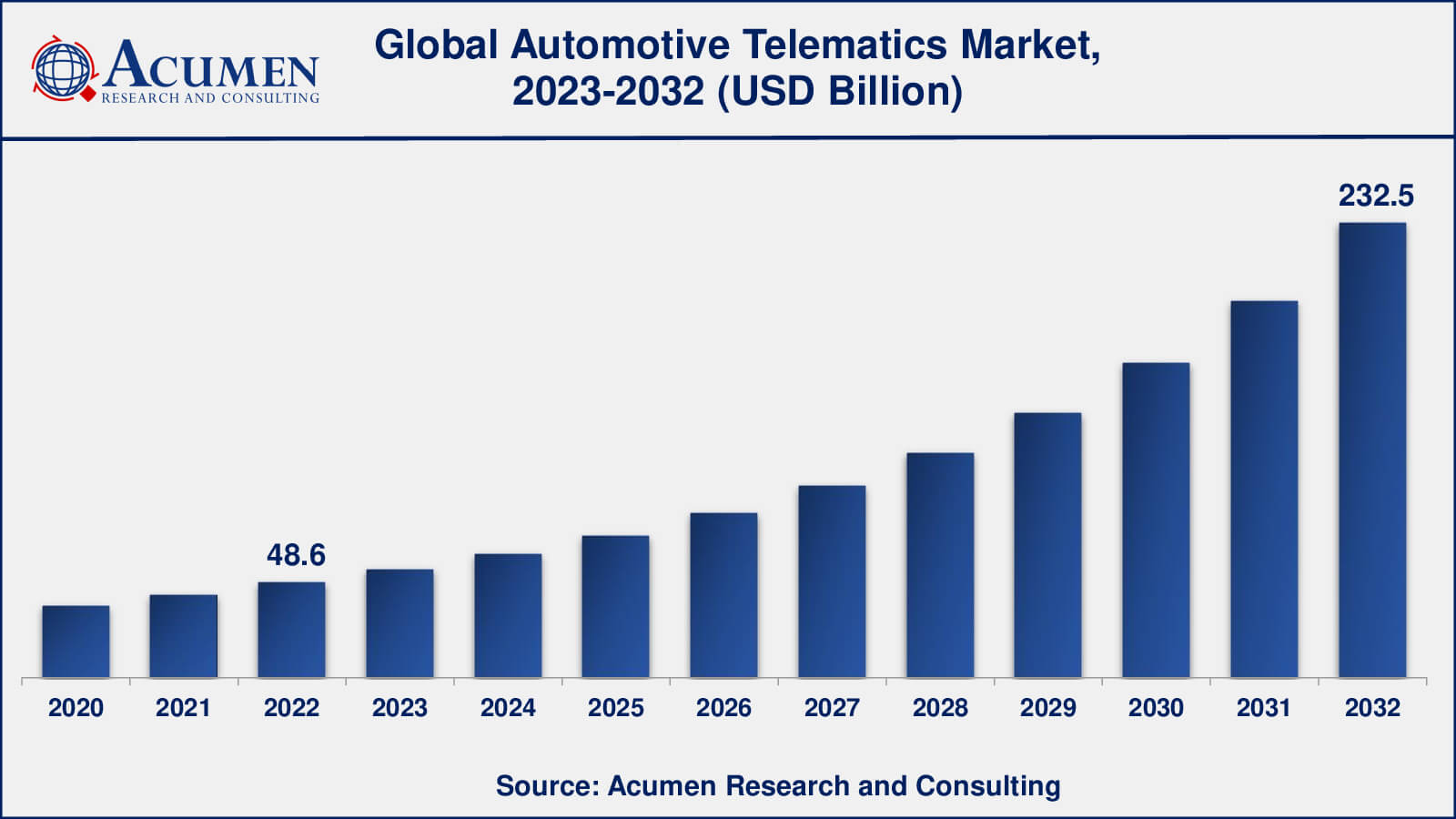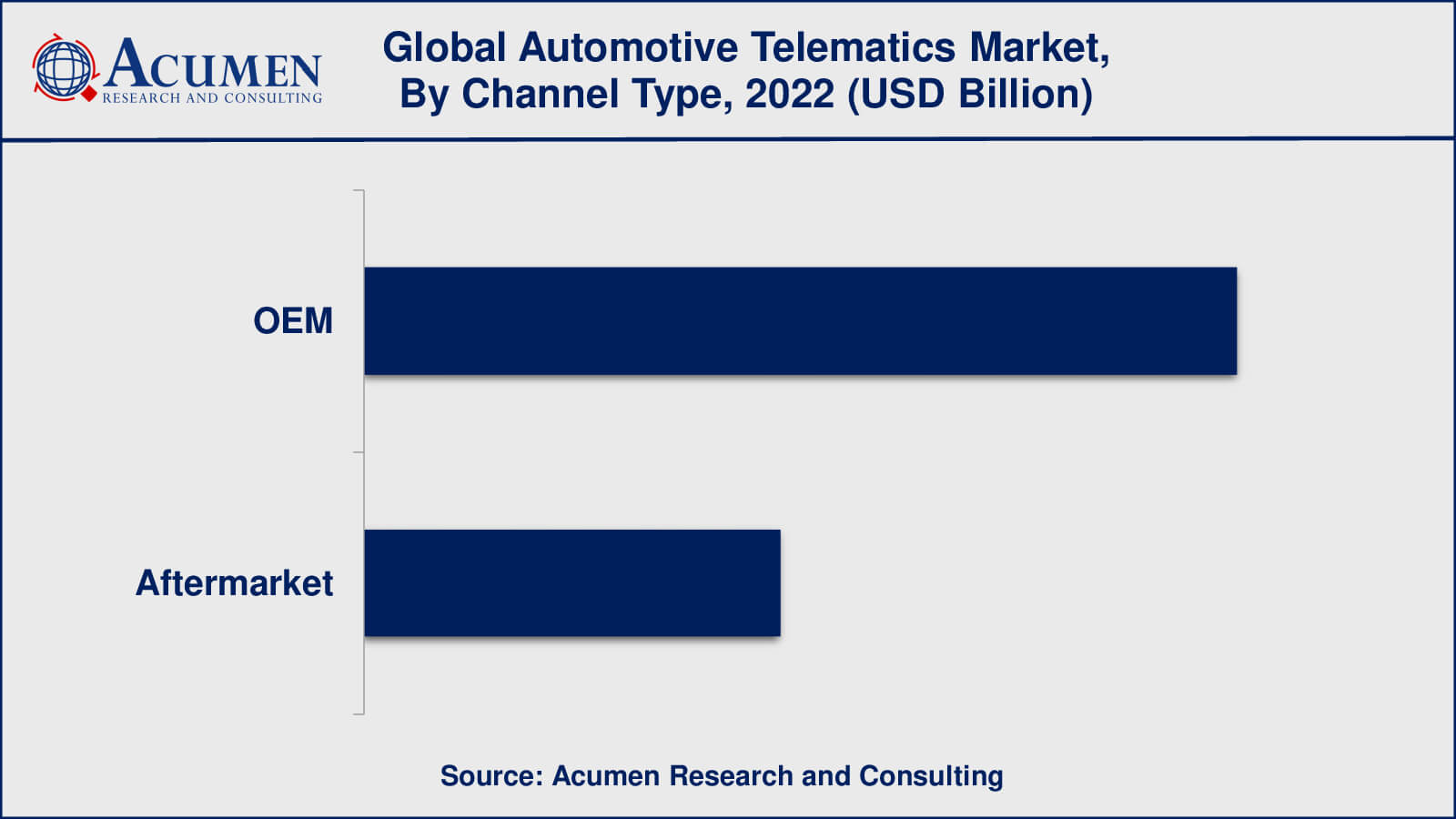Automotive Telematics Market Size - Global Industry, Share, Analysis, Trends and Forecast 2023 - 2032
Published :
Report ID:
Pages :
Format :
Automotive Telematics Market Size - Global Industry, Share, Analysis, Trends and Forecast 2023 - 2032
Report Coverage
- Industry Dynamics
- Market Size and Forecast Data
- Segment Analysis
- Competitive Landscape
- Regional Analysis with a Niche Focus on Country-Level Data
- High Level Analysis - Porter's, PESTEL, Value Chain, etc.
- Company Profiles of Key Players
- Option to Customize the Report As Per Your Specific Need
Request Sample Report
The global Automotive Telematics Market size was valued at USD 48.6 Billion in 2022 and is projected to attain USD 232.5 Billion by 2032 mounting at a CAGR of 17.3% from 2023 to 2032.
Automotive Telematics Market Highlights
- Global automotive telematics market revenue is poised to garner USD 232.5 billion by 2032 with a CAGR of 17.3% from 2023 to 2032
- Asia-Pacific automotive telematics market value occupied around USD 24.8 billion in 2022
- North America automotive telematics market growth will record a CAGR of more than 18% from 2023 to 2032
- Among channel type, the OEM sub-segment occupied over US$ 29.6 billion revenue in 2022
- Based on connectivity solutions, the embedded sub-segment gathered around 59% share in 2022
- Insurance companies promoting usage-based insurance through telematics is a popular automotive telematics market trend that drives the industry demand

Automotive telematics is the integration of telecommunications and information technologies into cars to enable data transmission and receiving. This technology enables automobiles to share data with distant systems such as data centers or other vehicles. Telematics in vehicles is accomplished by the use of a variety of hardware devices, sensors, software applications, and communication networks.
One of the fundamental goals of automobile telematics is to collect and communicate real-time data from the vehicle's many sensors and systems. This data may contain details about the vehicle's performance, engine health, fuel economy, tire pressure, and other factors. Telematics systems may give significant insights to both drivers and fleet operators by collecting and analyzing this data, allowing them to optimize vehicle performance, increase fuel economy, and improve overall safety.
Telematics systems enable connectivity with other sources in addition to internal vehicle data. This feature is very beneficial for navigation and location-based services. Vehicles equipped with GPS technology may access mapping and routing information, giving drivers with real-time traffic updates and optimized routes to their destinations.
Another critical use of automobile telematics is vehicle tracking and monitoring. Fleet managers, for example, may use telematics to keep track of their cars' whereabouts, monitor driver behavior, and efficiently manage their total fleet. This aids in improving operating efficiency, optimizing routes, lowering fuel consumption, and improving overall fleet safety.

Global Automotive Telematics Market Dynamics
Market Drivers
- Increasing demand for connected car services and advanced vehicle features
- Growing focus on vehicle safety and regulatory compliance
- Rising adoption of telematics in fleet management for improved efficiency
- Advancements in communication technologies and IoT integration
Market Restraints
- High initial costs of telematics hardware and software implementation
- Concerns about data privacy and cybersecurity
- Limited infrastructure and network coverage in certain regions
- Resistance from traditional automotive industry players to embrace telematics
Market Opportunities
- Integration of 5G technology to enhance data transmission and connectivity
- Expansion of telematics applications in autonomous and electric vehicles
- Growing aftermarket telematics services for older vehicle models
Automotive Telematics Market Report Coverage
| Market | Automotive Telematics Market |
| Automotive Telematics Market Size 2022 | USD 48.6 Billion |
| Automotive Telematics Market Forecast 2032 | USD 232.5 Billion |
| Automotive Telematics Market CAGR During 2023 - 2032 | 17.3% |
| Automotive Telematics Market Analysis Period | 2020 - 2032 |
| Automotive Telematics Market Base Year | 2022 |
| Automotive Telematics Market Forecast Data | 2023 - 2032 |
| Segments Covered | By Channel Type, By Vehicle Type, By Connectivity Solutions, By Application, And By Geography |
| Regional Scope | North America, Europe, Asia Pacific, Latin America, and Middle East & Africa |
| Key Companies Profiled | Airbiquity Inc., CARTRACK, Harman International Industries Inc., Masternaut Ltd., MiX Telematics, Omnitracs, Teletrac Navman, TomTom Telematics B.V., Trimble Inc., and VERIZON. |
| Report Coverage |
Market Trends, Drivers, Restraints, Competitive Analysis, Player Profiling, Covid-19 Analysis, Regulation Analysis |
Automotive Telematics Market Insights
The automotive telematics industry is undergoing substantial dynamics as a result of a number of reasons. The growing demand for linked car services and enhanced vehicle amenities is one of the key vehicle telematics market factors. Customers want more integrated and engaging experiences in their vehicles, which is driving the adoption of telematics technology that enables seamless connectivity, real-time data access, and personalized infotainment services. As manufacturers seek to provide better driving experiences, telematics is becoming increasingly important in converting conventional automobiles into smart, connected creatures.
Vehicle safety and regulatory compliance are increasingly top priorities for the automotive sector, making telematics a critical facilitator in solving these issues. Telematics systems monitor vehicle performance, driver behavior, and key safety data in real time, assisting in the prevention of accidents and enhancing road safety. Additionally, governments and regulatory agencies throughout the world are emphasizing the integration of telematics for safety compliance, which is boosting market growth.
Another key driver for the vehicle telematics industry is the fleet management sector. Telematics systems are being used by businesses to track and manage their fleets, optimize routes, minimize fuel consumption, and improve overall operational efficiency. Telematics gives fleet operators access to critical data on vehicle health, driver performance, and route analytics, resulting in cost savings and better customer service.
Telematics applications are expanding due to advancements in communication technology and the integration of the Internet of Things (IoT). The advancement of faster and more dependable communication networks, such as 5G, allows for uninterrupted data transmission and supports the rising demand for connected automobile services. Moreover, telematics and IoT integration enables effective data gathering, processing, and communication between cars and other smart devices, resulting in a full ecosystem for the automotive sector.
While the automotive telematics business offers several potential, it also confronts a number of hurdles and constraints. The high initial costs of telematics hardware and software deployment prevent widespread adoption, especially in price-sensitive industries which restricts the car telematics market growth. Then again, consumer and business concerns about data privacy and cybersecurity generate worries about the gathering and use of sensitive data.
Furthermore, inadequate infrastructure and network coverage in some places make widespread deployment of telematics services difficult. Connectivity concerns in such places might restrict the efficacy of real-time data transfer, limiting the dependability of telematics systems. Furthermore, due to current business models and organizational structures, conventional automotive industry participants may be hesitant to embrace telematics, limiting vehicle telematics market expansion in some locations.
Automotive Telematics Market Segmentation
The worldwide market for automotive telematics is split based on channel type, vehicle type, connectivity solutions, application, and geography.
Automotive Telematics Channel Types
- OEM
- Aftermarket

According to the automotive telematics industry analysis, OEM channel type accounted for the majority of the share in 2022. OEM telematics is the process of directly integrating telematics systems into new automobiles during the production process. Automobile manufacturers collaborate with telematics service providers to outfit their vehicles with integrated hardware and software that enables a variety of linked car features and services. OEM telematics are frequently included with the purchase of a car and offer seamless connection with the vehicle's current systems. This connection provides high dependability and performance, making it an appealing option for many customers. OEM telematics is gaining pace as the demand for connected car services and factory-installed safety features grows.
The aftermarket telematics channel, on the other hand, entails the installation of telematics equipment into vehicles that were not initially equipped with such technology during the manufacturing process. Third-party firms often provide aftermarket telematics solutions, which may be installed into current automobiles. This enables owners of older vehicles to have access to connected car services and enhanced features that were not accessible when the vehicle was purchased. Depending on the amount of functionality requested by the user, aftermarket telematics devices can range from simple plug-and-play dongles to more complex installations.
Automotive Telematics Vehicle Types
- Passenger Vehicle
- Commercial Vehicle
- Two Wheeler
According to the automotive telematics market forecast, passenger vehicles are expected to dominate the market in the future years. Passenger vehicles, such as automobiles, SUVs, and light trucks, have been at the forefront of telematics technology use. Automakers are progressively incorporating telematics systems as standard or optional equipment into their passenger vehicles. Several reasons contribute to the adoption of telematics in passenger automobiles. For starters, people are increasingly seeking connected automobile services and innovative technologies that improve the driving experience while also providing convenience, safety, and entertainment alternatives. Telematics technology offers features such as GPS navigation, real-time traffic updates, remote car diagnostics, emergency help, and entertainment services, increasing the appeal of passenger vehicles to customers.
While the passenger car category has dominated, telematics usage is rapidly spreading to other vehicle categories as well. Commercial vehicles, such as trucks, buses, and other fleet vehicles, have also begun to incorporate telematics systems in order to optimise fleet management, decrease fuel consumption, monitor driver behaviour, and increase operational efficiency. Furthermore, the two-wheeler industry has demonstrated telematics adoption potential, particularly in regions where motorcycles and scooters are widespread.
Automotive Telematics Connectivity Solutions
- Fleet/Asset Management
- Navigation & Location-Based System
- Infotainment System
- Insurance Telematic
- Safety & Security
- V2X
- Others
According to the our in-depth analysis, the automotive telematics market saw several connectivity solutions making significant impacts. Fleet/asset management was one of the market's main solutions, especially for commercial vehicles and fleet operators. Telematics technology enabled businesses to efficiently track and manage their vehicle fleets by allowing capabilities like real-time position tracking, route optimisation, remote diagnostics, and fuel monitoring. This technology aided businesses in streamlining processes, lowering expenses, and improving overall fleet efficiency.
Navigation and location-based systems were also important in the car telematics sector. Telematics systems provided precise navigation, turn-by-turn instructions, traffic updates, and places of interest information to vehicles through GPS integration and real-time data. Another prominent part of the telematics industry was infotainment systems. Modern telematics-enabled automobiles provided advanced infotainment systems that combined cellphones, entertainment services, voice commands, and internet access.
While the mentioned solutions were dominant, the telematics market also featured other innovative applications. These "Others" encompassed various additional telematics services, such as remote vehicle control, predictive maintenance, vehicle-to-vehicle communication, and more.
Automotive Telematics Applications
- Embedded
- Tethered
- Integrated

The automotive telematics industry was dominated by the integrated telematics application. The integration of telematics hardware and software directly into the vehicle during the manufacturing process is referred to as embedded telematics. Telematics components are integrated into the vehicle's current systems in this way, allowing for seamless communication and data access without the use of additional devices or cellphones. Because they are built to function in tandem with the vehicle's architecture, embedded telematics systems are often more resilient and dependable.
Several elements contributed to embedded telematics' prominence. For starters, automakers were progressively including integrated telematics as standard or optional equipment in new automobiles. Embedded telematics' ease and value-added services, such as navigation, remote diagnostics, emergency help, and linked entertainment, drew customers in and contributed to its broad acceptance.
Second, as compared to other types of telematics, such as tethered or smartphone-based systems, embedded telematics provided a more integrated and consistent user experience. Drivers and passengers could access connected car services directly from the vehicle's dashboard via embedded telematics, avoiding the need for additional devices and guaranteeing a smooth user experience.
Automotive Telematics Market Regional Segmentation
North America
- U.S.
- Canada
Europe
- U.K.
- Germany
- France
- Spain
- Rest of Europe
Asia-Pacific
- India
- Japan
- China
- Australia
- South Korea
- Rest of Asia-Pacific
Latin America
- Brazil
- Mexico
- Rest of Latin America
The Middle East & Africa
- South Africa
- GCC Countries
- Rest of the Middle East & Africa (ME&A)
Automotive Telematics Market Regional Analysis
North America was a pioneer in the use of automotive telematics. The desire for linked automobile features, fleet management solutions, and safety applications drove tremendous growth in telematics services in the United States, in particular. The region's telematics industry grew due to the existence of established telematics service providers, a favorable regulatory framework, and developments in communication networks.
Another important market for vehicle telematics was Europe. Telematics technology was widely used in countries like as Germany, the United Kingdom, and France. The European market saw a heavy emphasis on safety and regulatory compliance, with programmes encouraging the use of telematics in commercial fleets and passenger cars. Additionally, the expansion of the electric vehicle sector and growing interest in linked car services increased demand for telematics solutions in Europe.
The automotive telematics industry grew rapidly in the Asia-Pacific region. Countries such as China, Japan, and South Korea were early adopters of telematics. The rise of the automotive sector, increased awareness of vehicle safety, and government attempts to encourage smart mobility solutions all contributed to the region's success. The advent of ride-sharing services and smart cities has also increased demand for telematics apps.
Automotive Telematics Market Players
Some of the top automotive telematics companies offered in our report include Airbiquity Inc., CARTRACK, Harman International Industries Inc., Masternaut Ltd., MiX Telematics, Omnitracs, Teletrac Navman, TomTom Telematics B.V., Trimble Inc., and VERIZON.
Frequently Asked Questions
What was the size of the global automotive telematics market in 2022?
The size of automotive telematics market was USD 48.6 Billion in 2022.
What is the automotive telematics market CAGR from 2023 to 2032?
The automotive telematics market CAGR during the analysis period of 2023 to 2032 is 17.3%.
Which are the key players in the automotive telematics market?
The key players operating in the global automotive telematics market are including Airbiquity Inc., CARTRACK, Harman International Industries Inc., Masternaut Ltd., MiX Telematics, Omnitracs, Teletrac Navman, TomTom Telematics B.V., Trimble Inc., and VERIZON.
Which region dominated the global automotive telematics market share?
Asia-Pacific region held the dominating position in automotive telematics industry during the analysis period of 2023 to 2032.
Which region registered fastest CAGR from 2023 to 2032?
North America region exhibited fastest growing CAGR for market of automotive telematics during the analysis period of 2023 to 2032.
What are the current trends in the global automotive telematics industry?
The current trends and dynamics in the automotive telematics industry include increasing demand for connected car services and advanced vehicle features, growing focus on vehicle safety and regulatory compliance, and rising adoption of telematics in fleet management for improved efficiency.
Which channel type held the maximum share in 2022?
The OEM channel type held the maximum share of the automotive telematics industry.



